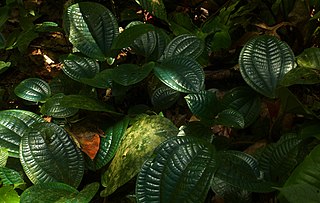
Strobilanthes is a genus of about 350 species of flowering plants in the family Acanthaceae, mostly native to tropical Asia and Madagascar, but with a few species extending north into temperate regions of Asia. Many species are cultivated for their two-lipped, hooded flowers in shades of blue, pink, white and purple. Most are frost-tender and require protection in frost-prone areas. The genus is most famed for its many species which bloom on long cycles of several years, such as Strobilanthes wightii which blooms every thirteen years.

Elaeocarpus is a genus of nearly five hundred species of flowering plants in the family Elaeocarpaceae native to the Western Indian Ocean, Tropical and Subtropical Asia, and the Pacific. Plants in the genus Elaeocarpus are trees or shrubs with simple leaves, flowers with four or five petals usually, and usually blue fruit.

Osbeckia is a genus of plants in the family Melastomataceae. It was named by Carl Linnaeus for the Swedish explorer and naturalist Pehr Osbeck (1723–1805).

Glycosmis is a genus of flowering plants in the citrus family, Rutaceae and tribe Clauseneae. It is in the subfamily Aurantioideae, which also includes genus Citrus. It is a genus of the subtribe Clauseninae, which are known technically as the remote citroid fruit trees.

Hopea is a genus of plants in the family Dipterocarpaceae. It contains some 113 species, distributed from Sri Lanka and southern India to the Andaman Islands, Myanmar, southern China, and southward throughout Malesia to New Guinea. They are mainly main and subcanopy trees of lowland rainforest, but some species can become also emergent trees, such as Hopea nutans.

Lasianthus is a genus of flowering plants in the family Rubiaceae. They are tropical subshrubs, shrubs, or rarely, small trees. They inhabit the understory of primary forests.

Memecylon is a plant group in Melastomataceae. It consists of 350-400 species of small to medium-sized trees and shrubs occurring in the Old World tropics. Memecylon is a monophyletic group basal to the Melastomataceae clade. Memecylon taxa have more than 600 published basionyms. Diversity of this group is concentrated in tropical Africa, Madagascar, Sri Lanka, India and Malaysia.

Miliusa is a genus of plants in family Annonaceae. Species have been recorded from tropical and subtropical Asia to northern Australia.

Urophyllum is a genus of flowering plant in the family Rubiaceae, native to from south China to Tropical Asia. The genus was established by Nathaniel Wallich in 1824.

Argostemma is a genus of flowering plants in the family Rubiaceae. It can be found in (sub)tropical Asia and western and west-central tropical Africa.
Hedyotis (starviolet) is a genus of flowering plants in the family Rubiaceae. Many species of this genus such as Hedyotis biflora, H. corymbosa and H. diffusa are well known medicinal plants. Hedyotis is native to tropical and subtropical Asia and to islands of the northwest Pacific. It comprises about 115 species. The type species for the genus is Hedyotis fruticosa.
Dissochaeta is a genus of plants in the family Melastomataceae. Species can be found in: Hainan and Indo-China through to Malesia.

Phyllagathis is a genus of flowering plants in the family Melastomataceae, native to India, southern China, Southeast Asia, and Malesia. The taxon is believed to be highly polyphyletic.
Anerincleistus is a genus of flowering plants belonging to the family Melastomataceae.
Oxyspora is a genus of flowering plants belonging to the family Melastomataceae.











